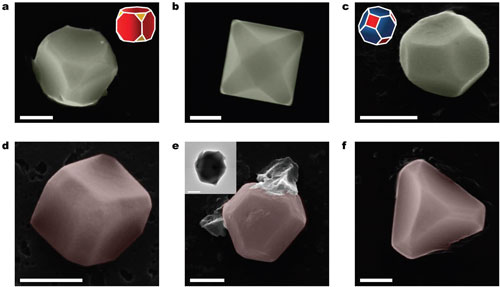| Posted: Jun 15, 2017 | |
A simple platform to achieve polymorphic graphene quantum dots(Nanowerk News) Researchers at the University of California, San Diego, have demonstrate a simple platform to achieve architectural polymorphs of graphene quantum dots (GQDs) by maneuvering the intra/intermolecular interactions of the constituent GQDs in binary solution systems. |
|
| The team from UCSD's Heller Lab published their findings in Advanced Materials ("Polymorphic Architectures of Graphene Quantum Dots"). | |
| The team explored GQDs composed of multiple aromatic rings designed to alter bandgap and surface states as a constituent material in optoelectronic devices. | |
 |
|
| Architectural diversities of GQDs crystals with reaction times. a–c) SEM images of GQDs with reaction times required to produce superlattices such as truncated hexahedron and octahedron. d–f) SEM images of A8GQDs with reaction times required to produce shapes such as edge-truncated hexahedron, truncated octahedron, and cuboctahedron. TEM image of truncated octahedron shown in the inset of (e). Scale bars, 200 nm. (© Wiley-VCH Verlag) (click on image to enlarge) | |
| The scientists delineate a simple synthetic platform to achieve the architectural diversities of GQDs-based structured materials in a binary solution system. | |
| By examining the conventional driving force to crystallization, the GQDs polymorphs can be further diversified by exploiting the intimate association of GQDs with solvents, resulting in the highly faceted structures by forming efficient molecular packings and tuning the cohesive energies of crystal facets. | |
| The structured GQDs superlattice is constructed by forming layer-by-layer internal structures and also exhibit structurally-guided photoluminescence behaviors associated with regulated charge transfer during the crystallization, which are determined by comparison with the structural evolution and amplification of photoluminescence emission intensity as crystallization proceeds. | |
| The team points out that the exquisite regulation of GQD pair potentials can further achieve the architectural diversities of a GQD superlattice: truncation by bonding with hydrocarbon ligands and one- or two-axial growth by maneuvering the intimate associations with solvents. | |
| "Therefore, we believe that our insights into the understanding of GQD superlattice formation will give a facile and exquisite manufacturing pathway for designing structured graphitic carbon-based materials and producing hybrids composed of 2D nanostructures to regulate photonic and electronic behaviors toward practical uses,". |
 By
Michael
Berger
– Michael is author of three books by the Royal Society of Chemistry:
Nano-Society: Pushing the Boundaries of Technology,
Nanotechnology: The Future is Tiny, and
Nanoengineering: The Skills and Tools Making Technology Invisible
Copyright ©
Nanowerk LLC
By
Michael
Berger
– Michael is author of three books by the Royal Society of Chemistry:
Nano-Society: Pushing the Boundaries of Technology,
Nanotechnology: The Future is Tiny, and
Nanoengineering: The Skills and Tools Making Technology Invisible
Copyright ©
Nanowerk LLC
|
|
|
Subscribe to a free copy of one of our daily Nanowerk Newsletter Email Digests with a compilation of all of the day's news. |
